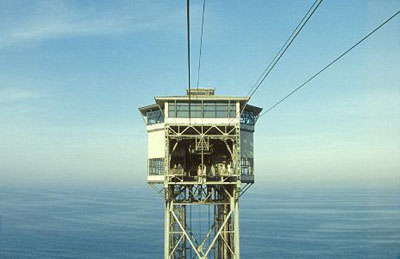 Runa Islam Time Lines "Time Lines proposes in an intricate web of references a new paradoxical look at the city: the city that stands there to be observed and enjoyed as it is filmed is also a city that doesn't exist, since ultimately it only exists in its own cinematic reality." (Miguel von Hafe Pérez) White Cube is pleased to present "Time Lines", a new work by Runa Islam - the first film that the artist has shot and projected on 35mm. "Time Lines" focuses on three early twentieth century structures in Barcelona: the once iconic cable car of Montjuic whose linear journey is now used primarily as a tourist excursion, and two rides in the antiquated Tibidado fairground - a plane that moves in a fixed circle overhead and a crane that rotates upwards to what was formerly the highest point in the city. Islam was drawn to these subjects not because of their immediate visual appeal (the cable car's small red box skimming the city's rooftops for example, or the candy coloured ironwork of the rides) but rather for the impossible airborne points of view that they access and for the perfect readymade tracking shots enabled by their automated functions. Like Richard Serra's "Railroad Turnbridge" (1976), these constructions provide both the subject and the method of the filmmaking process, from which the images could develop "in a free associative way, moving laterally and literally, vertically and horizontally." "Time Lines" deals with notions of suspension and the deconstruction of time/space coordinates in both a literal and metaphorical manner. Scenarios and "timeframes" are montaged in the film, using both amateur and professional actors in period costumes ranging from the 1900s to the present day set against intermittent points of the cable car's journey. Fragments of physiognomies, clothing and architectural details are syncopated together, with overlaid sounds of ambient noise, 1920s music and the amplified hum of turn-of-the-century engineering. Occasionally, the camera cuts to the cable lines in the sky, a completely abstract composition, and then switches back to long shots of the car taken from a roving viewpoint. As is often the case with Islam's films the actors are simply left to appear, functioning more like narrative decoys; obstructions rather than points of entry into any logical plot line. In this way, the work reflects Bresson's notion of characters being "formed" on film, something that the artist has employed in earlier works such as "Screen Test / Unscript" (2000) where close-ups are used to transform faces into characters on screen and "First Day of Spring" (2005) where a group of rickshaw drivers were choreographed to simply sit and do nothing in antithesis of their daily labour. Although Islam often engages documentary techniques such as behind-the-scenes shots of crew and camera and occasionally shots of herself directing the scene, the works always rest in the space between the viewer's collusive identification with film as fantasy or fiction and the "authenticity" of the documented image. In this way, she utilises the self-analytical construction and disruptive chronology of Structuralist filmmaking as a way to draw attention to the very artificial space of cinema. In "Time Lines", narrative set-ups are used more as vehicles to situate the city, from its vast expanse of sky to its horizontal rooftop panorama, the latter a motif that has frequently appeared in Islam's work: a city snowstorm in "Dead Time" (2000) for example; the banal architectural tropes of twin port cities Oporto and Rotterdam in "Parallel" (2001) and the urban sprawl of Newcastle Gateshead in "Scale (1/16 inch = 1 foot)" (2003). Islam makes connections between the "architecture" in her films and the installation space, creating a network of visual relationships that begins with the images on screen and ends with the particular set of spatial coordinates developed for each film. These range from intimate single screen 16mm projections ("First Day of Spring", "Be the First to See What you See as you See It" (2004), "Dead Time" and "Stare Out (blink)" (1998)), to architecturally-scaled multiple screen DVD installations ("How Far to Fårö" (2005), "Scale (1/16 inch = 1 foot)" and "Parallel"), each calibrated to enhance the ability of film to act as a material conduit into a projected mental space. Islam has exhibited internationally in group shows such as 8th Istanbul Biennial (2003), 51st Venice Biennale (2005) and Göteborg International Biennial (2005). Recent solo exhibitions include Dunkers Kulturhus, Helsingborg, Camden Arts Centre, London, UCLA Hammer Museum of Art, Los Angeles and Mart, Trento. "Time Lines" was commissioned and produced by Centre d'Art Santa Mònica, Barcelona with the support of Göteborg International Biennial for Contemporary Art 2005. A full colour pamphlet with an essay by Sara Arrhenius will be available during the exhibition. Exhibition: 9 December 2005 - 14 January 2006 Gallery hours: Tues-Sat 10 am - 6 pm White Cube 48 Hoxton Square GB-London N1 6PB Telephone +44 020 7930 53 73 Fax +44 020 7749 74 80 www.whitecube.com |